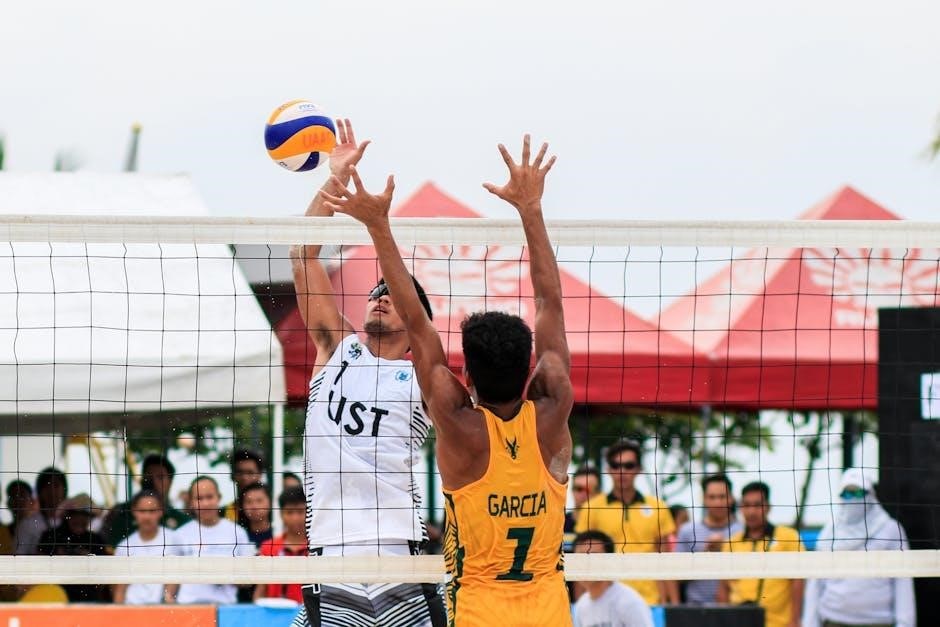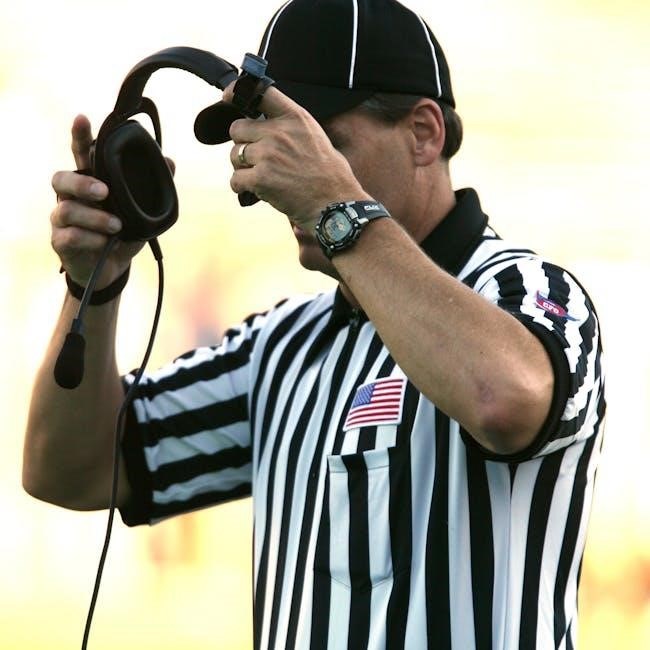NFHS Volleyball Rules 2023-2024: Key Changes and Interpretations
The National Federation of State High School Associations (NFHS) annually updates volleyball rules. The 2023-24 revisions address coaching zones, jewelry allowances, and uniform number contrast. These changes aim to clarify rules and improve gameplay for high school volleyball.
The National Federation of State High School Associations (NFHS) sets the standard for high school volleyball rules in the United States. These rules govern interscholastic play, emphasizing fair competition and player safety. The NFHS rule book is updated annually to reflect changes, clarifications, and interpretations. Coaches, officials, and players must familiarize themselves with the current rules to ensure compliance. The NFHS also provides resources like case books and online courses to aid understanding. These resources clarify complex situations and promote consistent application of the rules. Understanding the NFHS rules is crucial for participation and success in high school volleyball programs.

2023-2024 Rule Changes Overview
The 2023-24 NFHS volleyball rule changes include revisions to coaching zone regulations, jewelry allowances, and uniform specifications. These adjustments impact coaching strategies, player attire, and officiating protocols during high school volleyball matches.
Expanded Coaching Zone
The 2023-24 NFHS volleyball rules introduce an expanded coaching zone, defined by the libero replacement zone. This area extends beyond the end line and sideline. Head coaches must maintain a six-foot distance from the sideline during live-ball situations, but they may approach during dead balls. The expansion allows greater freedom for coaching communication. One assistant coach may stand to communicate with the players. This change intends to provide better in-game guidance. The rule modifications aim to enhance coaching strategies and player development within the NFHS volleyball framework.
Jewelry Allowance Clarification
The NFHS has clarified its stance on jewelry in the 2023-24 volleyball rules. Small, secured stud or post jewelry is now permissible above the chin. However, no jewelry is permitted below the chin. This change provides a specific guideline for acceptable jewelry during play. The aim is to balance safety concerns with individual expression. The rules are designed to prevent injury and maintain a safe playing environment. Officials must be vigilant to enforce the jewelry regulations. This clarification offers teams and players a clearer understanding of what is allowed regarding jewelry.
Uniform Number Contrast Rule
Beginning in 2023, the NFHS mandates that the body of the uniform number must clearly contrast with the uniform top, irrespective of any border or trim. This rule ensures readability for officials and spectators alike. It helps to quickly identify players during gameplay. If a uniform violates this rule, the match proceeds, but the supervisor of officials is notified. This allows for correction and compliance in future matches. The rule aims to minimize confusion and maintain the integrity of the game by ensuring clear player identification. Clear contrast is key to uniform legality.

NFHS Rule Book and Case Book
The NFHS provides an official rule book and case book annually. These resources assist officials, coaches, and players in understanding and applying the rules. Both are available in paperback and ebook formats.
Availability of the NFHS Rule Book
The NFHS Volleyball Rule Book for the 2023-2024 season is available in both print and digital formats. High school coaches, officials, and administrators can acquire it through the NFHS website or authorized distributors. The digital version is accessible via an app on phones or tablets, offering convenient access to the rules. This resource outlines regulations for all NFHS volleyball matches and provides interpretations. Access to the official rule book is essential for ensuring fair play and consistent application of the rules at all levels of competition within high school volleyball programs nationwide.
Use of the Case Book
The NFHS Volleyball Case Book serves as a companion to the official rule book. It offers detailed interpretations and specific scenarios to clarify the application of rules in various game situations. Officials, coaches, and players can use the Case Book to understand the rationale behind the rules and how they are applied in practice. It includes examples and rulings on common situations encountered during matches. It is a vital tool for improving understanding of the rules and promoting consistent officiating and fair play. The Case Book is available alongside the rule book, both in print and digital formats.
Impact of Rule Changes
The NFHS volleyball rule changes for 2023-24 affect coaching strategies, officiating, and player understanding. Adjustments are needed to comply with new guidelines, leading to revised approaches and potential interpretation challenges during matches.
Coaching Strategies and Adjustments
With the expansion of the coaching zone, head coaches must now maintain a six-foot distance from the sideline during live play, but can approach during dead balls. One assistant coach is now allowed to stand and communicate with players, impacting in-game communication strategies. These changes necessitate adjustments to coaching protocols and real-time decision-making, requiring coaches to adapt their positioning and interaction methods. Teams will need to refine substitution strategies and communication techniques, ensuring efficient play within the new coaching parameters and leveraging the expanded zone effectively for optimal player support and tactical adjustments.
Officiating and Interpretation Challenges
The updated NFHS volleyball rules for 2023-2024, particularly regarding jewelry allowances and uniform number contrast, present new challenges for officials. Determining whether jewelry is a small, secured stud/post above the chin requires careful judgment. Assessing adequate contrast between uniform numbers and tops, regardless of trim, demands precise evaluation. These subjective elements may lead to varied interpretations among officials. Clear communication and consistent application of these rules are crucial to avoid disputes. Training and resources, like the NFHS Case Book, are vital for equipping officials to confidently navigate these interpretation challenges and ensure fair play.
Comparison with Other Volleyball Rule Sets
PAVO develops annual documents comparing NFHS rules with NCAA and USA Volleyball rules. These resources highlight differences in playing surfaces, coaching protocols, and other regulations, aiding coaches and officials in understanding the nuances across various volleyball levels.
NFHS vs. NCAA Rules
Significant differences exist between NFHS and NCAA volleyball rules. PAVO creates comparison documents to highlight these variations annually. Key areas of divergence include regulations regarding the playing surface and specific coaching protocols. For example, the coaching zone in NFHS extends beyond the end line. Jewelry allowances also differ, with NFHS permitting small secured studs or posts above the chin. Uniform rules, particularly concerning number contrast, have distinct interpretations. These documents aid officials and coaches in navigating the nuances of each rule set.
NFHS vs. USA Volleyball Rules
Comparing NFHS and USA Volleyball rules reveals several distinctions impacting gameplay. PAVO develops annual documents outlining these differences, aiding understanding. One area of divergence lies in uniform regulations. NFHS rules emphasize clear contrast between the uniform number and top. Coaching protocols also vary, influencing how coaches interact with players. Jewelry allowances present another key difference, with specific restrictions in each rule set. Officials and coaches benefit from understanding these nuances to ensure fair competition under the appropriate guidelines. The documents will aid in the navigation of each rule set.

Resources and Support for Coaches and Officials
The NFHS offers online education courses for coaches and officials. State associations also provide support. These resources help with rules understanding and proper application, improving the overall volleyball experience for everyone involved.
NFHS Online Education Courses
The National Federation of State High School Associations (NFHS) provides a range of online education courses designed for coaches, officials, parents, and students involved in high school athletics. These courses cover various aspects of volleyball, including rules interpretations, coaching techniques, and safety protocols. Access to these resources ensures that individuals are well-informed and prepared for the volleyball season. The NFHS online platform offers convenient and accessible training modules, contributing to a higher standard of officiating and coaching across the nation. These educational tools are vital for promoting fair play and player development.
State Association Support
Each of the 51 NFHS member state associations provides resources and support to high schools within their jurisdiction regarding volleyball rules and regulations. These associations often offer clinics, workshops, and training sessions for coaches and officials to ensure consistent interpretation and application of NFHS rules. State associations also serve as a point of contact for clarifying rule interpretations and addressing specific concerns related to volleyball programs. They play a vital role in promoting fair play, player safety, and the overall integrity of high school volleyball within their respective states. Furthermore, they may offer additional guidelines tailored to their local context.

NFHS Rule Revisions Posters
The NFHS provides free rule revisions posters highlighting changes for the new volleyball season. These posters are available as downloadable PDFs for coaches, administrators, and state association representatives to easily share key updates.
Availability of Free Posters
To ensure widespread knowledge of the updated volleyball regulations, the NFHS is providing free rule revisions posters for the current high school season. These posters serve as a quick and accessible reference for coaches, administrators, and state association representatives. They can be easily downloaded as PDF files from the NFHS website, allowing for convenient distribution and display in gyms, offices, and other relevant locations. This initiative helps promote a consistent understanding and application of the latest rule changes across all participating schools and teams, ultimately enhancing the fairness and integrity of high school volleyball.
Rule 4-2 Penalty Clarification
Rule 4-2 outlines the penalty when a team cannot field six legally uniformed players. Officials must now notify the state association in such cases, ensuring proper documentation and consistent enforcement of the rule.
Inability to Uniform Six Players
The NFHS has clarified the penalty associated with a team’s inability to uniform six players, as outlined in Rule 4-2. This rule mandates that officials must report such instances to the relevant state association. This addition ensures that state associations are informed when a team cannot meet the minimum player requirement due to unforeseen circumstances. The goal is to maintain fair play and consistent application of the rules across all member schools. This reporting helps track the reasons behind the inability to uniform six players, contributing to data-driven decisions regarding rule adjustments and support for schools facing such challenges. The emphasis is on procedural adherence and transparency.
2024-2025 Rules Interpretation
The NFHS provides annual rules interpretations. The 2024-2025 interpretations offer clarifications and guidance for officials, coaches, and players. These resources ensure consistent rule application and address common scenarios encountered during high school volleyball matches.
Availability of 2024-2025 Rules Interpretation
The NFHS makes the 2024-2025 volleyball rules interpretations accessible through various channels. These interpretations are crucial for officials, coaches, and administrators to ensure consistent and accurate application of the rules. Check the NFHS website for downloadable documents and online resources. State associations may also provide access to these interpretations. Utilizing these resources promotes fair play and a comprehensive understanding of the updated regulations for the volleyball season. Accessing these interpretations allows for proactive preparation and helps address any potential ambiguities in the rule book, leading to smoother and more consistent officiating across all levels of play.